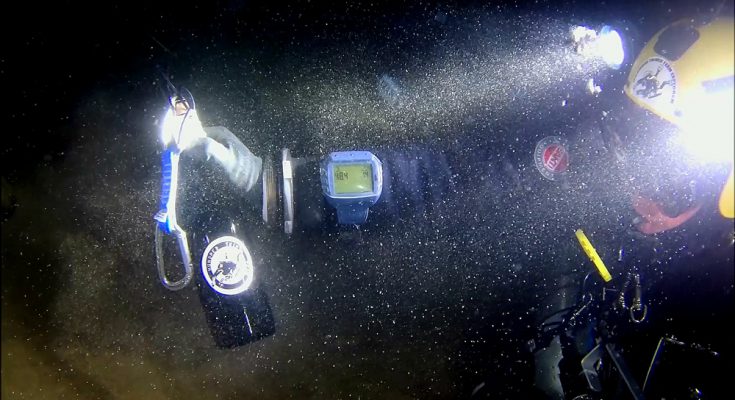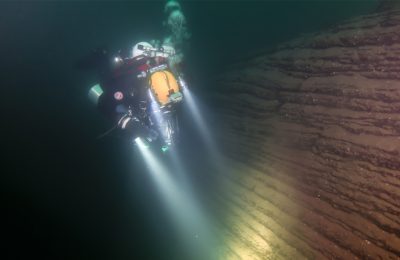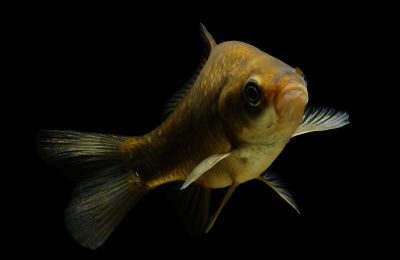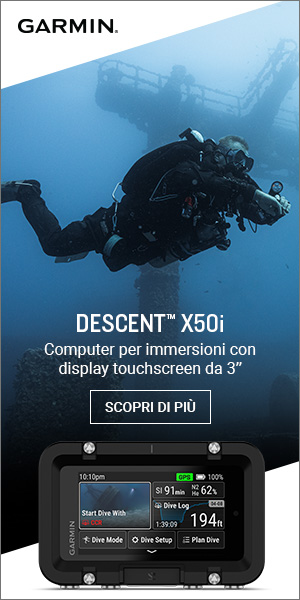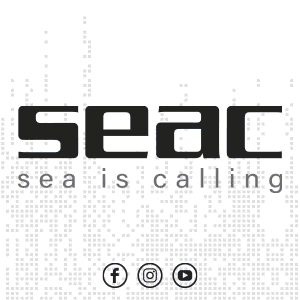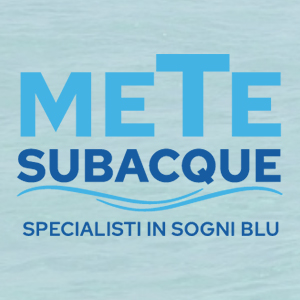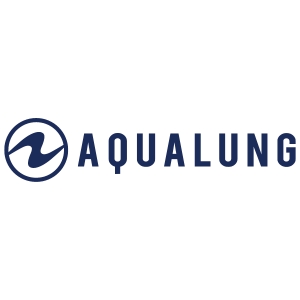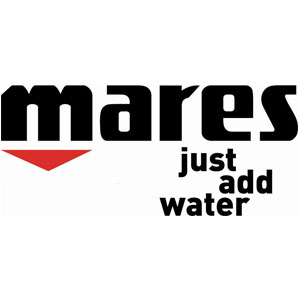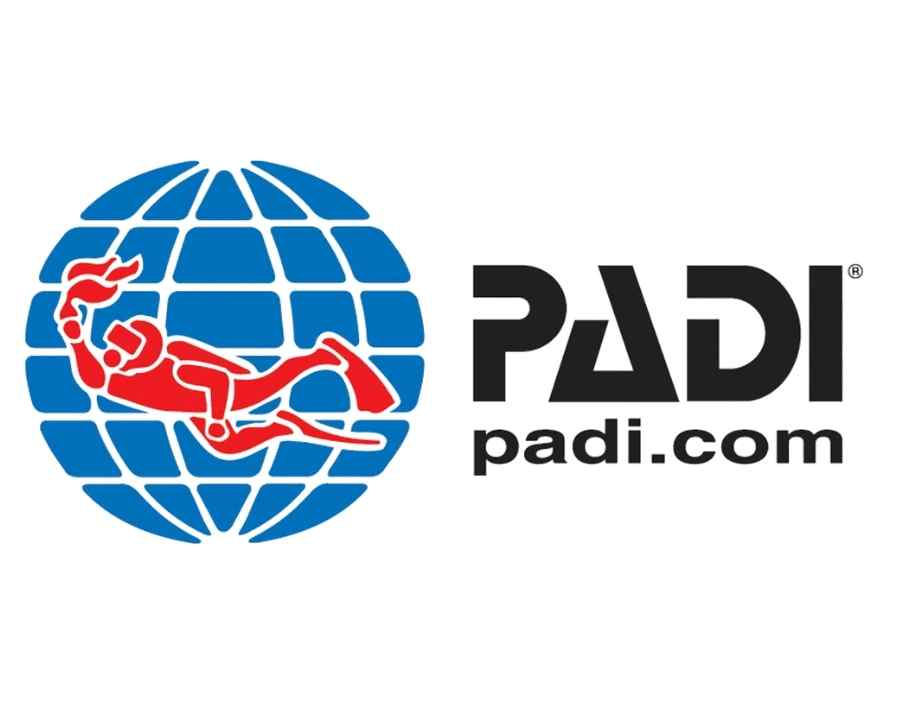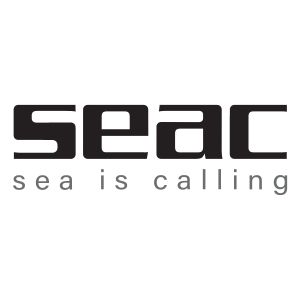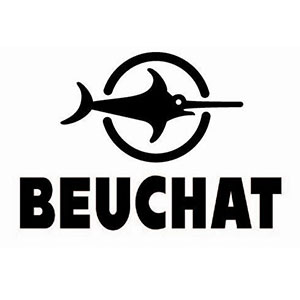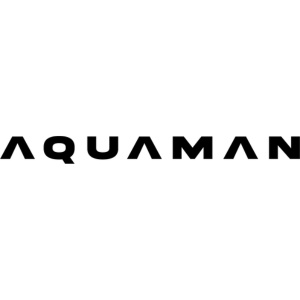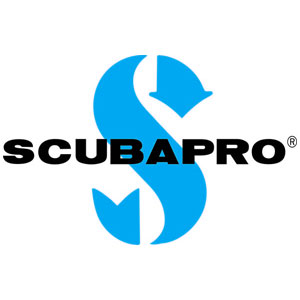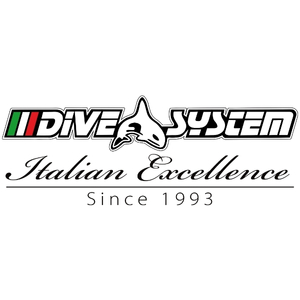Vino sul fondo del lago, bottiglie di vino immerse nelle profondità del Lago
È proprio vero che molte avventure nascono da semplici battute “messe lì a caso”. E proprio da una di queste uscite, qualcuno ha proposto un’idea un po’ folle: “Ma cosa ne dite se invece di fare la solita immersione non pensiamo di…”
…e poi qualcuno prende la “fresconata” sul serio, e da cosa nasce cosa.
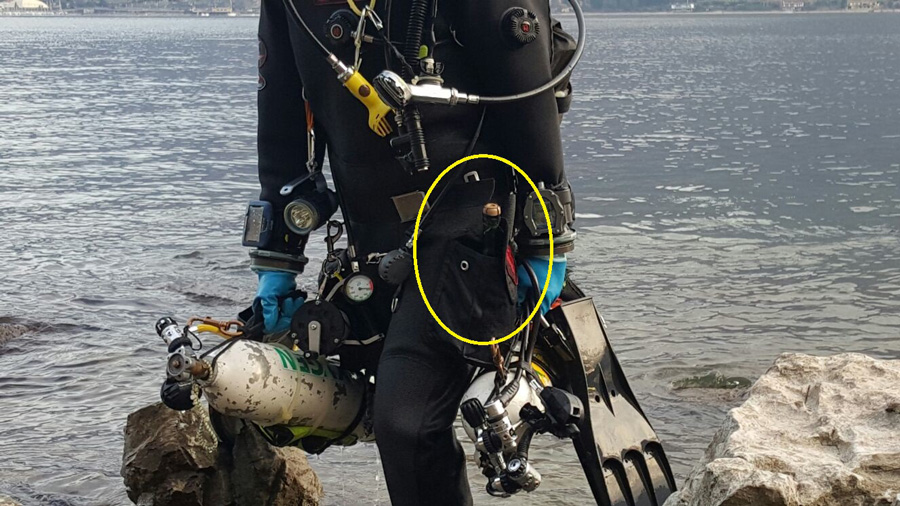
Immersi nelle profondità del canyon: una routine subacquea che si ripete
Tutto questo successe già nel lontano 2014 oramai quasi 10 anni fa …quando per puro gioco e divertimento, con Ivan Rolli ed il resto del team decidemmo di portare la PRIMA BOTTIGLIA di vino giù lungo il canyon della “nostra house reef” al Lago di Como, di cui allego la intrippante scheda del tuffo tipico (Juan Cito – Un tuffo nel canyon )
La lasciammo lì per vari mesi, per poi rifarla emergere …come si dice … “alle feste comandate “…di solito a Pasqua e Natale. Da allora, abbiamo sempre sfruttato l’occasione di rifornire la nostra piccola ma particolarissima cantina con il vino che annualmente andiamo ad acquistare in stagione primaverile nell’azienda vinicola per poi imbottigliarlo “…per spaccio, uso e consumo personale “(si dice così, no? Ah Ah Ah !!)
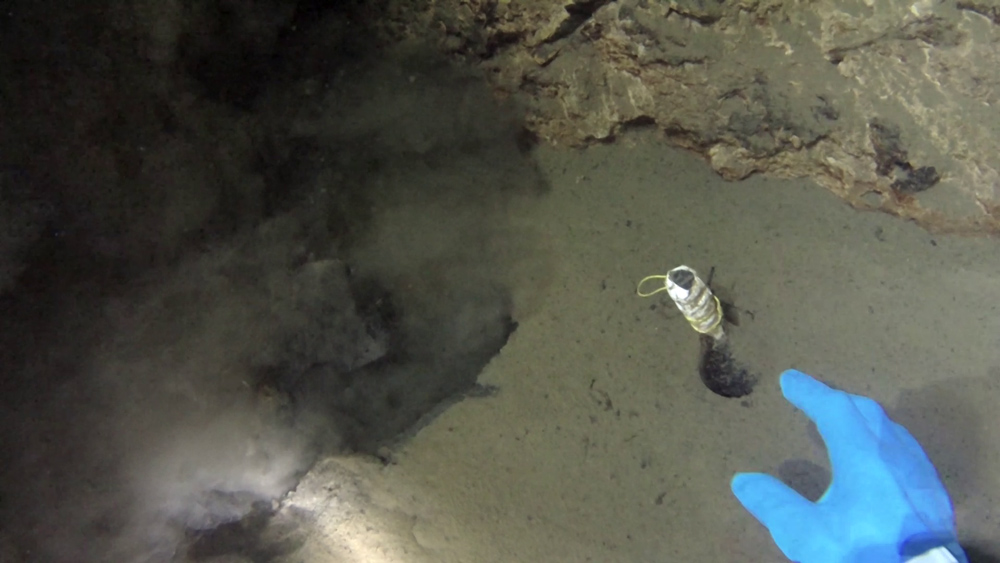
Tra le profondità e la sicurezza: riflessioni subacquee tecniche e pratiche
Sebbene si potesse finalizzare questa idea su altri siti subacquei, magari più facili da raggiungere, per noi è diventata automaticamente routine e normalità posizionare alla base del canyon e sotto alla nostra targa le bottiglie, per vari motivi. Uno di questi è la creazione di un obiettivo da analizzare nei vari particolari e poi perseguire.
La profondità non raggiungibile proprio da tutti, (subbi lestofanti e gaglioffi – adoperando termini gentili ed antichi- ce ne sono comunque).
Un altro focus è il compiere un gesto un pochino “anormale”, collegandolo alla quasi normalità dell’immersione tipica ad alta profondità. Già …” attenta consuetudine “… E qui molti potrebbero arricciare il naso e alimentare qualche critica sia sulla profondità sia sul fatto di trasportare bottiglie a “quella” profondità. Tema generale, sicurezza dell’immersione sportiva, ecc. tra l’altro già affrontato ampiamente su queste pagine ed in tutto il mondo sub. Ma in questa sede, sorvoliamoci sopra a piè pari.
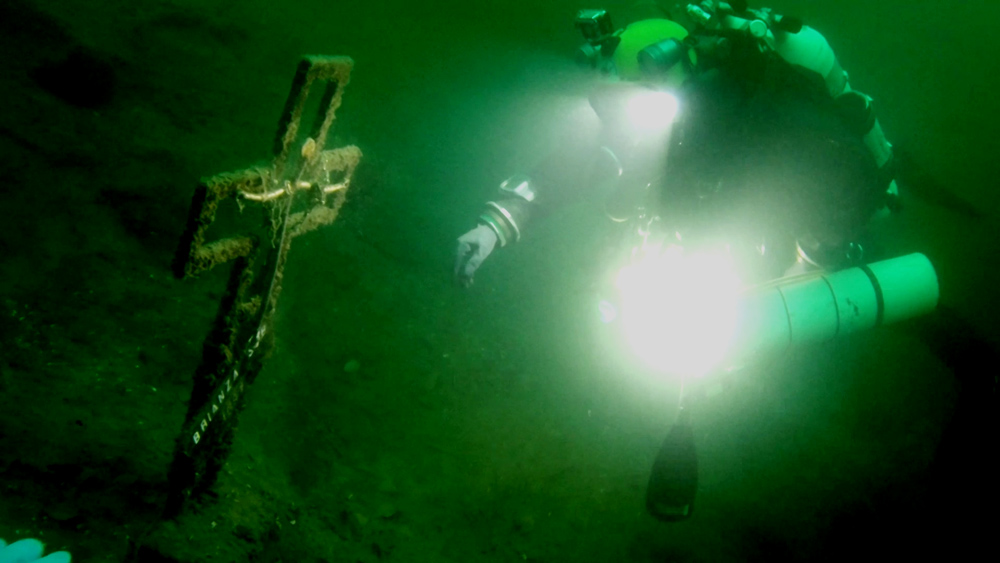
Operazioni sub che vanno effettuate con il giusto addestramento
Va sottolineato e detto che queste operazioni, vanno effettuate sempre con il giusto addestramento, seguendo sempre e comunque le nozioni tecnico teoriche importantissime e basilari legate al proprio brevetto. In aggiunta, tengo ad evidenziare anche la praticità, manualità e propensione di ogni subacqueo, a certe esercitazioni in acqua (vedi pratiche di lavori subacquei oppure addestramenti in condizioni particolari ed ostili come operazioni di Protezione Civile).
Scrivendo questi “distinguo”, voglio dire che un conto è effettuare una normale immersione sportiva con tutti gli aspetti standard sotto controllo, un altro è portare particolari oggetti nelle tasche della muta stagna o appesi al gav, e compiere particolari operazioni in acqua. Ad esempio, togliere o mettere una semplice bottiglia in una tasca della muta stagna, magari già occupata da spool, maschera di scorta e tabelle, con la presenza magari ingombrante di due stage laterali, presuppone una buona gestione di tutto. E tutto questo parte a monte da un buon briefing sulla dislocazione logistica e scelta della dotazione di attrezzi subacquei, i gas respirati, chi fa cosa dove e quando, ecc.
Chiusa questa doverosa parentesi tecnica, apriamo ora quella più ludica – scientifica-e pure culinaria/enologica altrettanto interessante.
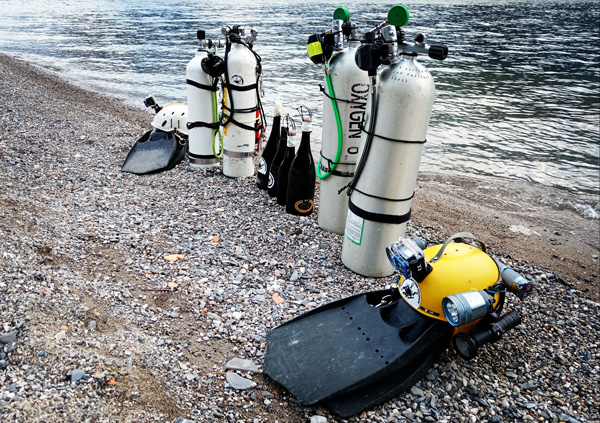
Vino sott’acqua, un’iniziativa fuori dal comune
Perché il vino sott’acqua? Dieci anni fa, in pochi pensarono di portarlo sott’acqua. Forse qualche azienda sarda o ligure aveva già realizzato l’idea, ma non ne abbiamo traccia. Ma poco importa ai nostri fini: non siamo qui a vedere chi l’ha fatto prima!
Ora, a distanza di tanti anni, molte imprese hanno investito denaro per portare in mare o in alta quota un certo quantitativo di bottiglie di vino…. vuoi per business, vuoi per cavalcare l’onda del ritrovamento avvenuto anni fa di circa 300 bottiglie di champagne ritrovate in un antico relitto invecchiato di circa 170 anni che ufficialmente avevano un sapore ottimo, anche se realmente corre “sottovoce” tra gli addetti ai lavori che proprio il sapore di quel vino non esisteva più: forse l’emozione di poterlo assaggiare dopo così tanto tempo aveva influenzato ogni assaggiatore.
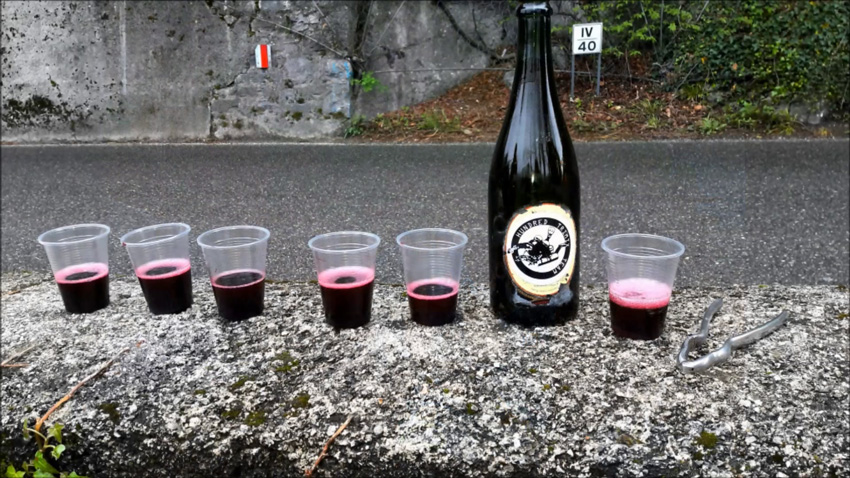
Ritornando per un attimo all’operato di alcune aziende vinicole, appare che queste depositino le bottiglie in mare ad una profondità tra i 30 e 40 metri, dove sicuramente la luce solare arriva a lambire le bottiglie, dove forse esiste qualche piccola corrente marina che però non influisce assolutamente sulle bottiglie, (il moto ondoso non arriva così in profondità per muovere le bottiglie) e dove la temperatura di circa 16/18 gradi invece può determinare qualche cambiamento.
Molti dicono che questo vino è stagionato più velocemente ed il sapore “maturo” è stato conseguito in minor tempo. Comunque, asseriscono che il gusto è diverso e quant’altro …Non sappiamo se ciò sia vero, oppure quanto incida sul reale gusto questo è il business della “novità”.
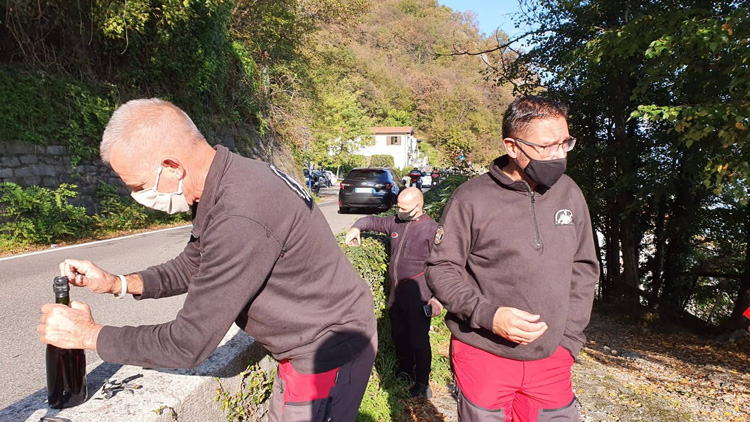
L’esperimento del gutturnio: tra lago e degustazione
Nel nostro caso, la questione invece è NETTAMENTE INVERTITA.
Nel corso di tutti questi anni, abbiamo notato che il vino depositato nel lago era considerevolmente diverso e anche migliore del medesimo vino presente nel nostro box/cantina. Ma perché tutto questo? Ne eravamo proprio sicuri? Non è che anche noi ci facevamo prendere la mano dall’impresa? Ed allora dopo vari ripensamenti, volevamo arrivare ad una sicura conclusione tecnica / scientifica. Ma come fare?
Ed ecco che ci è venuto in aiuto il nostro “fornitore” di Gutturnio: Simone Manara. Maître de chai della pregiata azienda vinicola, già conosciuta nel campo della ristorazione con il nome “LA FERRAIA “,ci ha spianato la strada. Da decenni ci riforniamo qui di ottimo vino, ogni anno pluripremiato in vari concorsi regionali, nazionali ed internazionali, e Ortrugo, Malvasia, Chardonnay, Barbera, Bonarda sono a livelli decisamente superiori.
La nostra scelta invece si è indirizzata sul pregiatissimo Gutturnio “frizzante e fermo “cavalli di battaglia dell’azienda.
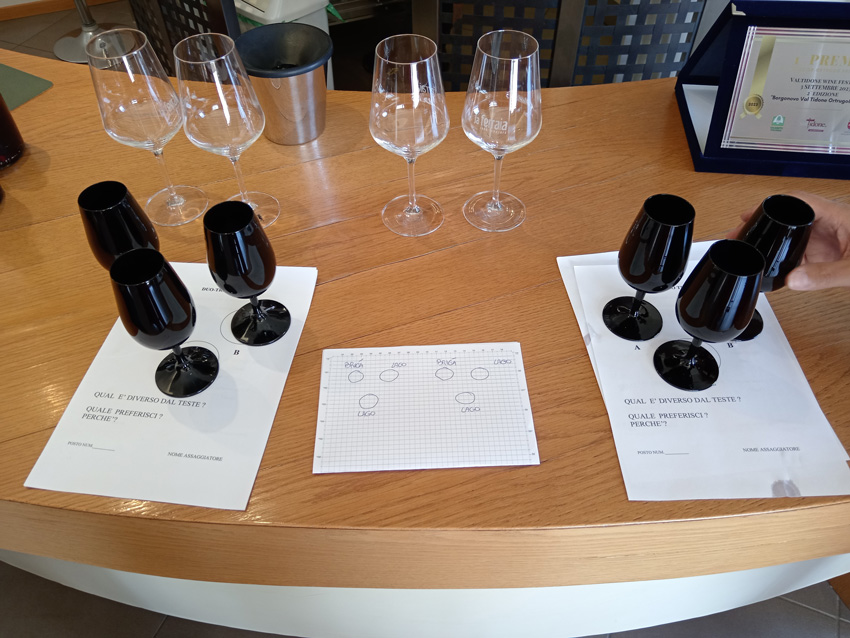
Operazione Lago: i primi dati tecnici del vino immerso sott’acqua
Che cosa abbiamo fatto? Imbottigliato il vino ai primi giorni di aprile, il giorno 10 del mese abbiamo portato in acqua bottiglie di “Gutturnio frizzante, e Gutturnio fermo”, e anche due magnum di pari qualità; Bottiglie chiuse ermetiche con tappo da spumante in plastica, sigillate con gabbietta e nastro. Dopo esattamente 6 mesi di permanenza in acqua, al buio totale, ed alla temperatura costante di 7/8 gradi massimo, abbiamo riportato in superficie e consegnato i campioni per la verifica enologica.
Alla Cantina La Ferraia, attorniata dalle dolci colline dei colli piacentini, Simone Manara ci ha presentato Giuseppe Meglioli persona colta e squisitissima, esperto e consulente enologo, profondo conoscitore e studioso di questo settore. Quale persona “curiosa sulle novità “ha preso a cuore il nostro esperimento, e nello splendido salone de La Ferraia, ha proceduto con estrema professionalità alla prima analisi.
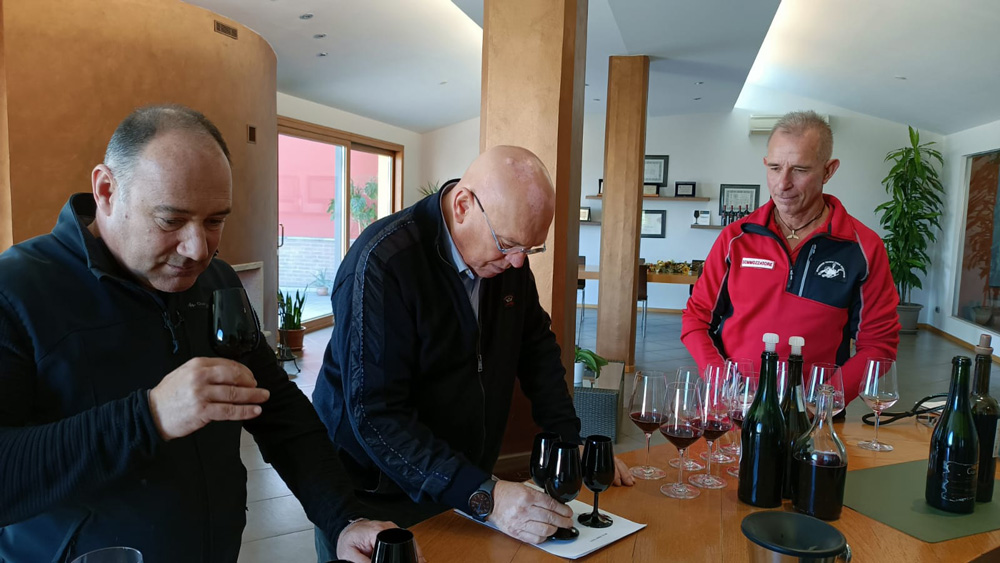
La parola agli esperti
Giuseppe, ci racconta:
Naturalmente, c’era grande curiosità per assaggiare questi due vini.
Abbiamo impostato l’assaggio con una scheda semplice con l’aiuto di Federica Bonello ricercatrice al CREA di Asti, che ci ha permesso di identificare se esisteva una differenza significativa.
Abbiamo usato il Duo-Trio Test che è un test che fa parte dei metodi Discriminanti Qualitativi usati nell’analisi sensoriale. Questa tecnica viene definita secondo la norma UNI ISO 6658/1987. Lo scopo di tale tecnica è di identificare eventuali differenze sensoriali tra un campione ed un riferimento. La domanda posta ad ogni assaggiatore è stata: Quale campione della coppia è identico a quello di riferimento? In seguito, quale campione preferisci?
Perbacco, è stata una sorpresa!!! Tutti noi siamo stati in grado di riconoscere distintamente i due campioni, sia nella tipologia frizzante (metodo ancestrale ovvero fermentazione naturale in bottiglia), che fermo e sempre abbiamo preferito quello che è stato affinato in fondo al lago.
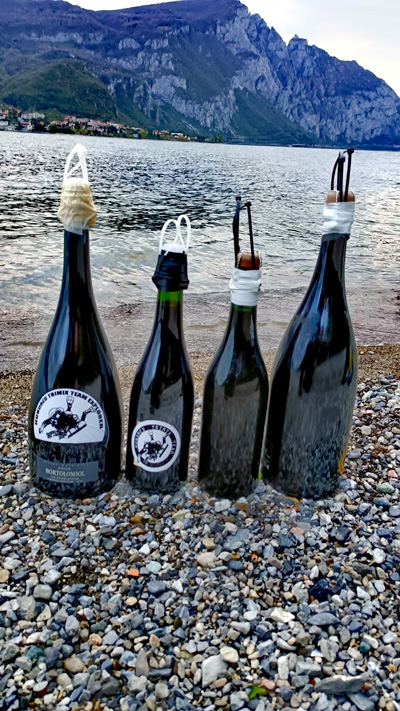
Caratteristiche del vino Gutturnio dei Colli Piacentini
Per chi non lo conoscesse riportiamo le caratteristiche del vino Gutturnio dei Colli Piacentini dai dati dell’enoteca dell’Emilia-Romagna nella versione frizzante e fermo sono le seguenti:
Il Gutturnio è il simbolo dell’enologia piacentina, amato dalla gente di questa zona e dai produttori che hanno a cuore e hanno voglia di sperimentare. Grazie alla loro voglia di trovare nuovi modi per apprezzare questo vino, il Gutturnio non è più un vino giovane e frizzante da bere durante tutto l’anno. Il regolamento stabilisce le regole anche per una versione ferma e una riserva, che deve aspettare 2 anni prima di essere commercializzata ed è meravigliosa al momento dell’assaggio.
Il Gutturnio nasce dall’assemblaggio di due vitigni complementari: la Barbera dona struttura e forza, mentre la Bonarda (localmente chiamata Croatina) dona eleganza e morbidezza. Poiché queste due uve hanno esigenze diverse in cantina, vengono vinificate separatamente e assemblate insieme solo in un secondo momento, in una proporzione che rispetta il disciplinare e segna lo stile specifico della cantina di produzione.
Le sue caratteristiche sensoriali sono: colore rosso vivace con sfumature violacee, al naso presenta sentori che vanno dal fruttato al fiorale, più o meno intenso a seconda della struttura del vino, con note di viola e ciliegia, quest’ultima caratteristica della Barbera e un caratteristico tono pepato che evolve in una speziatura più fine e complessa nelle riserva.
La nostra valutazione ha riguardato un vino giovane, quindi, ricercavano delle note fruttate e fiorali.
Si è evidenziato che queste caratteristiche erano migliori nel vino che aveva soggiornato in fondo al lago.
La curiosità, quindi, è aumentata e abbiamo sottoposto il vino ad analisi chimiche ed estrapolato i dati che riportiamo.
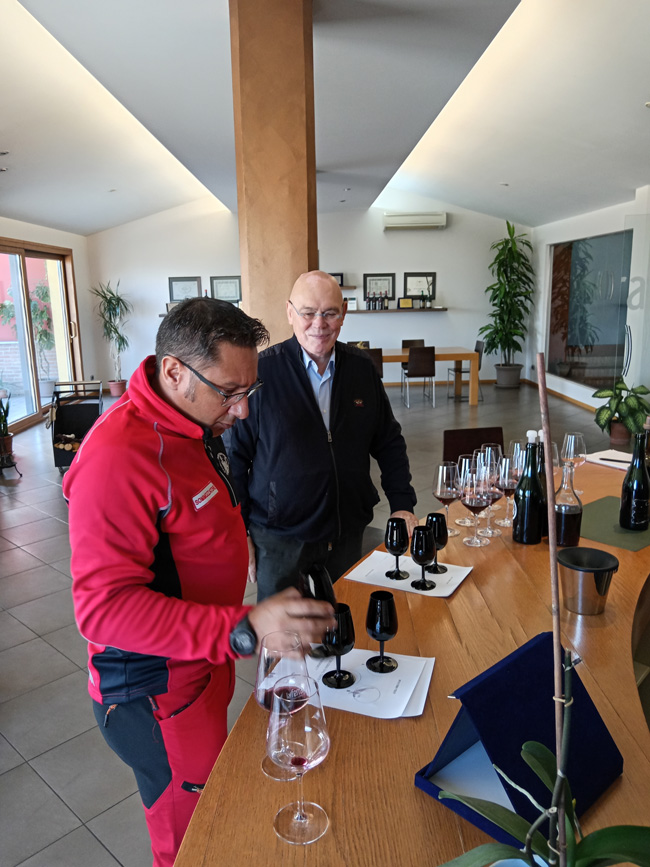
Test di laboratorio del vino sott’acqua
L’analisi statistica dei dati chimici ha evidenziato alcune differenze. Dal grafico si vede come i campioni conservati nel lago abbiano conservato un quantitativo maggiore di solforosa (che serve a conservare il vino) e rispetto all’omologo conservato tradizionalmente una tonalità colorante più bassa (che sta ad identificare tonalità più violacee).
Evviva abbiamo dimostrato che esiste una differenza e che alla degustazione il vino nel lago è migliore o perlomeno i fenomeni di maturazione del vino vanno a velocità inferiore!
La riflessione è: ma se avessimo una cantina a 7-8° gradi centigradi e al buio il risultato sarebbe stato lo stesso? Bella domanda. Come diceva il Manzoni che del lago di Como è un conoscitore nella ode “Il cinque Maggio” Ai posteri l’ardua sentenza”! Per il momento prosit!
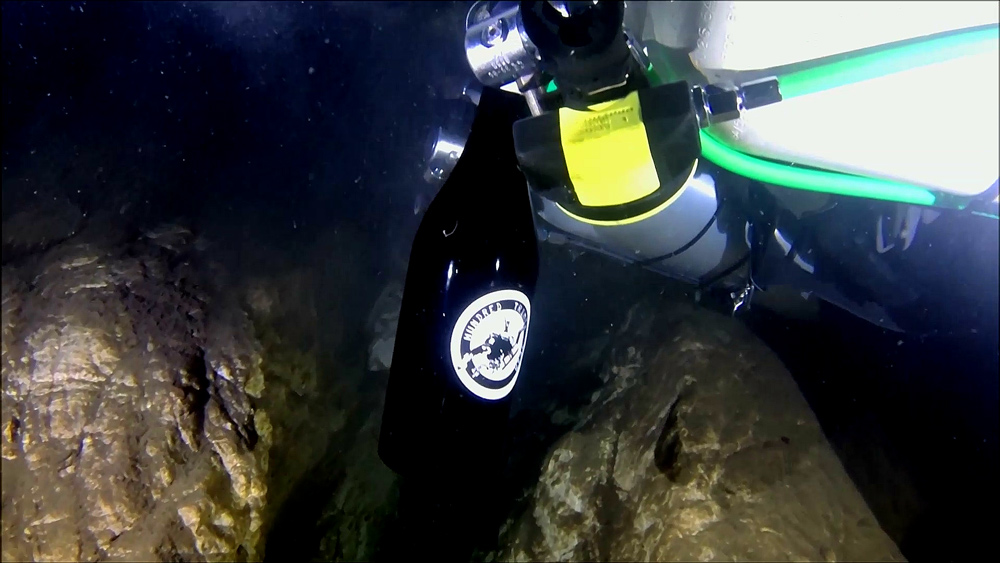
Conclusioni
“Per ora, e solo per ora…… “, Il nostro operato è finalizzato alla semplice goliardia e gioia di poter condividere l’ottimo Gutturnio con tutti gli amici che vengono al richiamo del “Deep Wine Day”, dove dopo una bella immersione in compagnia effettuata secondo i propri livelli, sulla riva del lago ci si stringe attorno a pane, salame, panettoni e colombe e quant’altro ci possa essere, per scambiarci genuini auguri e pensare magari a qualche altra …” fresconata “…
Articoli correlati: Birra in mare
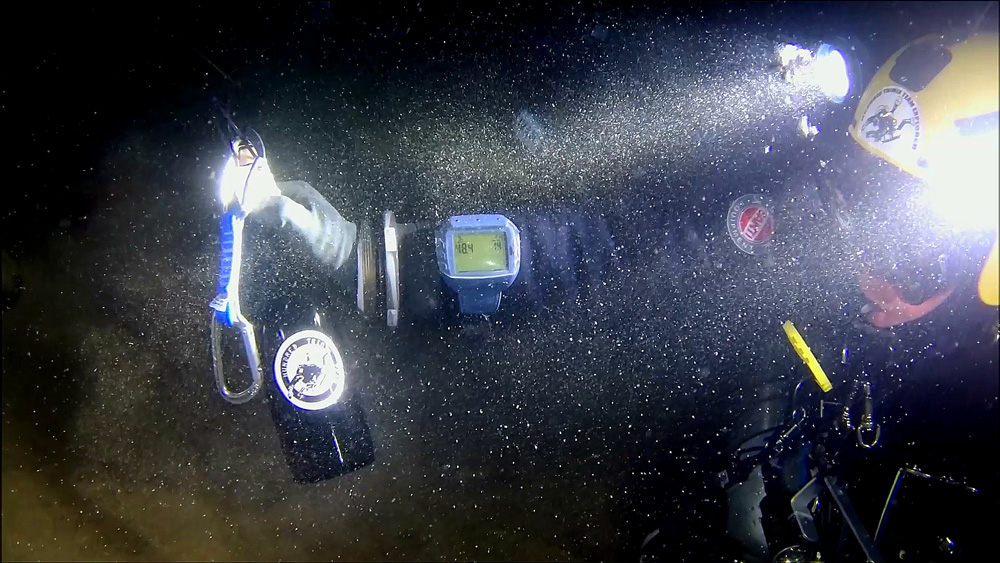
Deep wine day: red bubbles in very deep waters
Bottles of wine laid to mature in the deep waters of the lake, carefully conveyed into a canyon, now a sort of ritual among divers who party once the wine is ready to be unscrewed. Moreover a challenge from a safety and technical diving standpoint that requires a suitable training. For sure, a rather unusual dive.
The Italian wine Gutturnio let to age deep down in the lake has successfully passed the Oenological test as explained by the specialists.
Below the main characteristics of the Gutturnio, details of the lab analysis performed on the wine aged underwater together with some final considerations.
Bottles of wine under the fresh waters of the lake
Diving challenges are sometimes prompted by some weird idea or some insane joke, just for the sake of a change in the diving routine. It may happen that the gag is taken seriously, then “off we go”.
Bringing the bottle down into the canyon – now a consolidated habit.
All started 10 years ago in 2014, just for the fun, with Ivan Rolli and the diving team.
We decided to convey the first bottle of wine into a deep canyon under the surface of Lake Como.
A diving spot we know by heart that is fully described into the attached article (Juan Cito – Un tuffo nel canyon )
The bottle will be left there to mature for several months until we bring it up for a friendly toast during our diver’s get-together on Christmas or Easter. Obviously, this ritual requires that a new bottle goes down into our special cellar every other year.
We use to buy the wine in spring from a selected winery and bottle it on purpose.

Depth and safety – some technical and practical tips
The underwater aging of wine could be done in less deep and difficult diving spots, nonetheless we have chosen a place we know very well and that we keep monitoring (keeping out scuba scoundrels or cellar raiders – LOL).
The dive is a deep one that requires a suitable training and certification. For sure the transport of glass bottles at such depths is no typical diving activity and might arise some criticism as “not being by the book”.
Underwater activities that require a suitable training
This is a crucial aspect to keep in mind, being paramount to follow at any time the prescribed diving standards of one’s certification.
In my opinion, frequent underwater drills help to keep fit and handy, besides focused drills linked to special scuba ops, as for instance rescuing in adverse conditions and emergency management.
In other words, a normal dive performed according to the standards does not include carrying uncommon objects (as a bottle of wine) into the dry suit pockets or hanged loose to the BCD, less to execute unusual ops underwater. Dry suits pockets are for the spool, backup mask, tables etc. In addition, the possible use of two bulky lateral tanks makes everything harder; hence the above recommendations for a smooth and safe management.
Remember that the very first step is a thorough briefing that includes logistics, material, diving gears and types of breathing gases, plus “who does what and when”.
Now that all is set on the safety side, let us talk about the playful part of the story.
Wine underwater- quite out of the ordinary!
What is the purpose? About ten years ago, someone tried to store wine underwater, somewhere in Sardinia or Liguria, but the idea remained confidential.
Nowadays, many wine companies are investing money in this new way of ageing the bottles. It is fashionable and there has been much talking about the 300 bottles of Champagne stowed into a
170-year old wreck, apparently excellent to savour after all these years. Or was it more emotional than factual in light of such an extraordinary finding?
What is way to proceed?
Today the wine companies let the bottles under the sea at about minus 30-40 meters where the daylight is dim and the current too weak to interfere with the ageing process –the waves being too far above.
The temperature is about at 16/18 degrees, which is a suitable range for good ageing.
Many say that this wine has aged more swiftly and its taste is a mature one; even if somewhat different.
Is that so? Hard to say for sure…. At any rate it is something new.

Tasting the GUTTURNIO – Combining the lake and the wine
With respect to the above general opinion, our experience through the years shows the exact opposite. In short, the wine left underwater tastes considerably different and even better vs. the one left in our cellar. Why? Are we that sure? Could it be that our taste gets blurred by the diving challenge and excitement? To discard any misleading interpretation, we have decided to do things more scientifically. We have thus involved Simone Manara -our GUTTURNIO supplier and Maître de chai at the famous winey LA FERRAIA to set up the testing on his most appreciated wine among many others.
The first results – Probing the wine aged underwater
We had bottled the wine in early April. On April 10 we have brought down a bottle of Sparkling Gutturnio and one of still Gutturnio, plus two magnums of the same types. The bottles have been tapped by using a Spumante plastic cap, tightly sealed with a wire cage and a ribbon.
The wine has been laid underwater in complete darkness at a constant temperature of 7/8 Celsius degrees. After a sharp 6-month ageing, we have brought up the bottles and sent the samples to the Oenological experts for the testing.
We fixed a meeting with Simone Manara at the winey La Ferraia who introduced us to Giuseppe Meglioli – a friendly person open to new proposals, expert and consultant in Oenology and a reference in his field. He immediately adhered to our experiment and carried out the first professional evaluation into the cosy tasting room of the winery.

A word from the experts
Giuseppe told us he was curious and eager to try the wine left underwater.
The testing followed a check list, prepared with Federica Bonello a researcher at the CREA of Asti. Purposely, the scheme aimed to ascertain any notable difference by using the so-called “Duo-Trio Test”.
In the specific, it deals with a qualitative discriminating methods employed for the sensory analysis – a technique as per norm UNI ISO 6658/ 1987.It allows to spot out the sensorial differences between a reference sample and a probing sample. Each taster was then asked to identify which one of the two samples was identical to the reference sample then which one of the two samples they did like best.
What a surprise! All tasters clearly identified the two samples – sparkling (ancient method of natural fermentation in bottle) and still and all preferred the underwater aged wine.
Characteristics of the Gutturnio dei Colli Piacentini.
This wine is a typical product of the vineyards growing in the hills around Piacenza.
It is described by the wine shop as follows (for both the sparkling and still types):
The Gutturnio is very representative of its land and is appreciated locally. The winegrowers are open to any initiative that can enhance its promotion. It is not a prime sparkling wine for the everyday use anymore. Today standards are set for a still and a reserve wine, including a 2-year ageing before getting to the market, and the result is just gorgeous.
Gutturnio is assembled with two balancing grapes varieties: the Barbera for structure and strength and the Bonarda for elegance and softness. The winemaking of each grape type is performed separately from the other, then both are assembled according to fixed proportions that will confer its distinctiveness to the wine produced in a specific winery.
Its sensory characteristics are: bright red colour with purple shades, smell of fruits and flowers, more or less intensive according to the wine structure; notes of violet and cherry – this latter being typical of the Barbera, pepper notes to subtle spicy notes in the Reserve quality.
The tasting of this young wine focused on fruit and flower notes that were enhanced in the underwater aged wine. In short, something new that required further chemical analyses. Here below what the lab found out….
Lab test on the underwater wine
Some differences appeared in the statistics of the chemical data.
The bottles aged in the lake had a major quantity of sulphur (a wine preservative) vs. the same wine routinely aged, and had a lower colorant tone (which means they had a deeper purple colour).
Bingo! We have demonstrated that there are factual differences but moreover that the lake wine tastes better since the lake ageing is slower than the old-style one.
So at this point, cheers and enjoy!

As a wrap-up….
We much look forward to enjoying our funny get-together with our buddies and drink our favourite Gutturnio. After a nice dive, directly on the lake shore we share bread and salami, a Panettone or a Colomba cake and wish to all a Merry Christmas or a Happy Easter.
Long live to our “Deep wine Day!



